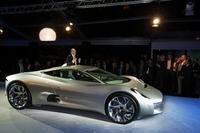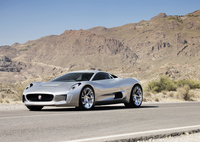Jaguar C-X75 Concept Four-Wheel Drive Electric Supercar Unveiled at 2010 Paris Motor Show - VIDEO ENHANCED
• Stunning range-extended electric supercar concept
• A celebration of 75 years of beautiful, fast Jaguars, points the way to
a new design language
• Capable of reaching 205mph (330km/h), sprinting from 0-62mph (100km/h)
in just 3.4 seconds and blistering acceleration from 50-90mph (80-145km/h)
in just 2.3 seconds
• • Four powerful 195bhp (145kW) electric motors -- one for each wheel --
produce 778bhp and an astonishing total torque output of 1,180lb ft
(1,600Nm)
• Two micro gas-turbines, spinning at 80,000 rpm, can generate enough
electricity to extend the range to a remarkable 560 miles (900 km); and
produce just 28 grams of CO2 per kilometer from the car's plug-in charge
capability
• A zero tailpipe emissions range of 68 miles (109km) while running
solely on battery power
 |
PARIS - September 29, 2010: Jaguar has revealed a stunning range-extended electric supercar concept car. The C-X75 has been designed to celebrate 75 years of the marque and provide a glimpse into the future of Jaguar and its commitment to producing beautiful, fast cars powered by sustainable means.
"The C-X75 is a tribute to the people who shaped the iconic Jaguars that are revered to this day. By making it an innovative test-bed for the technologies of tomorrow, it also ensures that our reputation for engineering excellence will continue for another 75 years and beyond," said Mike O'Driscoll, Managing Director, Jaguar Cars.
Click PLAY to watch highlights of the Jaguar Press Conference
 |
75 Years of Jaguar Design
The C-X75 hints at an exciting evolution of Jaguar's design language
while paying homage to some of its most admired cars of years gone by.
Advanced design features such as a ground-breaking propulsion system and
active aerodynamics allow for an elegantly simple fuselage section that
remains stable at very high speeds.
The C-X75 is finished in Jetstream Silver, its designers staying true to the long-held Jaguar design philosophy of natural, flowing lines and simple, elegant forms. Where inspiration from the past was found is in the innovative engineering and functional design elements of cars like the 1950s C-Type and D-Type racers and unique 1966 XJ13 Le Mans prototype -- a car described by Callum as "arguably the most beautiful Jaguar ever made."
Click PLAY to watch the "Design" video
Shorter and lower than the current crop of supercars, its exterior design is about pure performance with a simple central fuselage surrounded by prominent wheel arches. Thanks to the packaging efficiencies provided by the absence of a conventional piston engine, the car's designers had maximum freedom in placing the mechanical components and creating the most elegant engineering package available.
 |
According to Ian Cllum, Jaguar's Design Director, "The C-X75 is everything a Jaguar should be. It possesses remarkable poise and grace yet at the same time has the excitement and potency of a true supercar. You could argue this is as close to a pure art form as a concept car can get and we believe it is a worthy homage to 75 years of iconic Jaguar design."
Propulsion system
The 205mph (330km/h) four-wheel drive supercar is capable of running in
purely electric (zero tailpipe emissions) mode for 68 miles (109km) on a
six-hour domestic plug-in charge. The innovative, lightweight micro
gas-turbines are also capable of very quickly and efficiently recharging
the Lithium-ion batteries, giving the car a theoretical range of 560 miles
(900km).
This remarkable range-extension system is a result of Jaguar's research engineers adopting a clean-sheet approach to the question of powering the supercars of the future. The C-X75 turns to the very latest evolution of a pioneering British technology: the gas turbine.
Developed in partnership with Bladon Jets, the miniaturized turbine blade -- the first viable axial-flow micro-turbine -- increases the compression and efficiency of micro gas-turbines to the point at which they can be viewed as a realistic power source. Each of the micro gas-turbines weighs just 35kg and produces 94 bhp (70kW) of power at a constant 80,000rpm.
Power and control
The energy created by the turbines and stored in the batteries is
transmitted to the road using four independent electric motors. Using
individual motors has benefits in terms of weight-saving and distribution,
packaging and efficiency. Each motor weighs just 50kg but produces 195bhp
(145kW) of power and an astonishing combined total torque output of 1,180lb
ft (1,600Nm).
Because each wheel is driven by its own electric motor, the C-X75 is four-wheel drive -- with all the traction, grip and safety benefits that entails -- without the weight disadvantages of a purely mechanical set-up. Inherent in this drivetrain is the ability to independently vector torque to each wheel across the full speed range. This offers potential benefits in terms of stability and control, creating an infinitely and instantaneously adjustable traction and stability control system.
Click PLAY to watch the exterior video
Driver-focused cabin
With the seats fixed, the steering wheel, controls, main binnacle and
pedal box all adjust towards the driver. The seats are attached to the
bulkhead as in a single-seater racing car, and air to feed the turbines
passes smoothly around them via channels in the structure of the body.
A new interface for the driver has also been created for the C-X75 using high-resolution TFT screens. Building on Jaguar's 10-year expertise in touchscreen technology, the Jaguar Co-Pilot display in the centre console supports the driver in extracting the full potential of the C-X75 by seamlessly managing information.
The main driver information screen is housed within the instrument binnacle. Needles float on the periphery of the twin cowls and sweep round the outer edge to display the status and rpm of the two turbines. The design team combined designs from instrumentation in the new XJ saloon with those from fighter aircraft to create virtual 3D 'gimbals' around which the gauges wrap and rotate to provide status updates.
75 years of innovation
"Performance through innovation has always been a Jaguar trademark.
From the beginning, cars such as the C-Type and D-Type pioneered aluminum
construction, aerodynamic design, racing monocoques and disc brakes. The
C-X75 demonstrates that Jaguar is still leading the field automotive design
and technology. And will always continue to build beautiful, fast
cars," said Ralf Speth, Chief Executive Officer, Jaguar
Land Rover
Click PLAY to watch the "Innovation" video
Advanced aluminum lightweight construction
Jaguar's expertise in the use of aluminum stretches back more than 50
years to the first XK120s, through the lightweight E-Types, the XK and
all-new 2010 XJ. It was with this latter creation that Jaguar fully
realized the lightweight metal's benefits to performance, agility, economy
and sustainability in a luxury car.
The C-X75 naturally follows the same construction techniques with an extruded and bonded aerospace-inspired aluminum chassis clad in panels of the same material. Not only does this save weight, crucial in a car with an extreme performance envelope, but aluminum is one of the most easily recyclable metals available, boosting the C-X75's sustainability as well as its speed.
Active Aerodynamics
Aerodynamics have always played a large part in Jaguar design with the
late designer Malcolm Sayer elevating it
into an art form in cars such as the XJ13, the prototype from which the
C-X75 draws inspiration.
Jaguar has increased the design's aerodynamic efficiency dramatically by opening the front grille and brake cooling vents only when necessary. At the rear corners of the car vertical control surfaces automatically engage at higher speeds to direct airflow aft of the rear wheels for increased stability and efficiency.
The carbon-fiber rear diffuser, a crucial element in guiding airflow under the car and creating downforce includes an active aerofoil, which is lowered automatically as speed increases. Vanes in the exhaust ports then alter the directional flow of the gases to further increase the effectiveness of the Venturi tunnel.
From its beginning as a manufacturer of motorcycle sidecars in 1922, Jaguar Cars has grown to become one of the world's premier manufacturers of luxury sedans and sports cars and with that, one of the most recognized commercial brands. The company's vision is simple: To produce beautiful fast cars that are desired the world over. The company operates two manufacturing plants in the United Kingdom and is fully engaged in environmental programs, community work and brand awareness exercises such as motorsports.
Technical Specifications
|
|
||
|
Propulsion System & Transmission |
||
|
Electric motor |
Four 195bhp (145kW) traction motors (778bhp/ 580kW total) |
|
|
Generator |
Two switched reluctance generators |
|
|
Range Extender power |
2 x 94bhp (70kW) gas micro-turbines (188bhp/ 140kW total) |
|
|
Batteries |
Lithium-ion |
|
|
Total Battery Capacity (kWh) |
19.6 |
|
|
Transmission |
Single-speed |
|
|
Final Drive Ratio |
3.1:1 |
|
|
|
||
|
|
||
|
Performance |
||
|
0-100km/h (seconds) |
3.4 |
|
|
Top Speed (mph /km/h) |
205/330 |
|
|
0-160km/h (seconds) |
5.5 |
|
|
0-300km/h (seconds) |
15.7 |
|
|
1/4 mile (seconds@km/h) |
10.3@251 |
|
|
Max. Power (kW/BHP) |
580/778 |
|
|
Max. Torque (Nm/lb ft) |
1,600/1,180 |
|
|
Power to Weight ratio (BHP/ton) |
578 |
|
|
Aerodynamics (Cd) |
0.32 |
|
|
|
||
|
|
||
|
Economy |
||
|
EV range (km/miles) |
109/68 |
|
|
Extended range (km/miles) |
900/560 |
|
|
CO2 emissions (g/km) |
28 |
|
|
Fuel tank capacity (liters) |
60 |
|
|
|
||
|
|
||
|
Dimensions |
||
|
Wheelbase (mm/inches) |
2,725/107.28 |
|
|
Overall Length (mm/inches) |
4,647/182.95 |
|
|
Overall width (mm/inches) |
2,020/79.52 |
|
|
Overall Height (mm/inches) |
1,204/47.40 |
|
|
Curb weight (kg) |
1,350 |
|
|
Wheel size front and rear (inches) |
21 and 22 |
|
|
Tires (front and rear) |
265/30 ZR21 and 365/25 ZR22 |
|
|
Battery weight (kg) |
230 |
|
|
|
||




